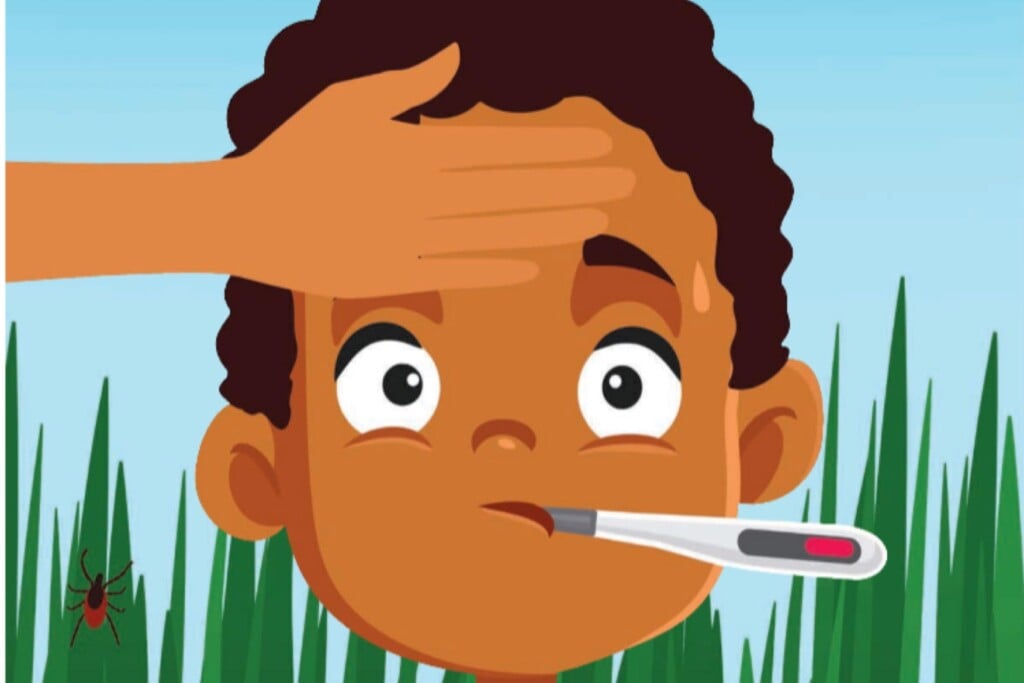A Fix For Ticks?
It’s prime season in Bergen for these tiny blood suckers. Learn how to protect yourself, your family and your pets.

It started with chills that swept over her at night but disappeared in the morning. They persisted for three nights, followed, says Sylvia Chase, by “the worst headache I’ve ever had.” It was the severity of that headache that prompted her husband to take her to an urgent care center near their Hackensack home, where the 73-year-old was diagnosed with possible ehrlichiosis, a tick-borne bacterial illness that’s relatively rare in Bergen County. A two-week course of antibiotics vanquished the disease, and Chase is now thankful for the headache that sent her to urgent care. “If I hadn’t had those classic symptoms,” she says, “I might not have been diagnosed, and the disease could have progressed without my knowing it.” Like most tick-borne illnesses, ehrlichiosis can be asymptomatic and often grows far more serious, and harder to treat, the longer it persists.
According to the New Jersey Department of Health, tick-borne diseases are on the rise in Bergen County and throughout the state: New Jersey’s reported cases of Lyme disease, for instance, increased from 5,092 in 2017 to 7,224 in 2023, and it’s likely that many more cases are going undiagnosed or unreported. In fact, New Jersey has the fifth-highest rate of Lyme in the U.S., and among its counties Bergen has the state’s sixth highest rate.
“Our area is a hotbed for tick-borne diseases, which can be caused by parasites, viruses and bacteria,” says Suraj Saggar, D.O., chief of infectious disease at Holy Name Medical Center in Teaneck. (Ticks themselves are parasites—specifically, ectoparasites, so called because they live on the outside of a host’s body. But they also can carry internal parasites, as well as viruses and bacteria, all of which can be transmitted to, and cause illness in, the animals—humans included—that they feed on.) The most common here are anaplasmosis and babesiosis, carried by the black-legged (or deer) tick; Rocky Mountain spotted fever, carried by the American dog tick, the brown dog tick and the Rocky Mountain wood tick; and, of course, Lyme disease, carried by the black-legged tick. All ticks are at their peak of activity in June and July, so this is a particularly important time to understand your risk of being bitten and learn the best ways to protect yourself, your family and your pets.
THE UPTICK
As it happens, ticks are active throughout the year in New Jersey these days, thanks to warmer temperatures that allow them to survive the winter. And because they’re no longer dying off in the winter, their populations are increasing. But the most significant factor in their rise is the dramatic growth of our deer population. “The increase in deer started in the 1980s, as a lot of farms became reforested and the deer became really well adapted to suburban environments,” says Matt Bickerton, an entomologist with the Bergen County Department of Health. “Deer are a host for many ticks, and they move around a lot, which helps spread the ticks and get them established in new areas.” Deer, of course, aren’t the only hosts for ticks in our area. Small mammals like mice, chipmunks and voles often carry tick nymphs (ticks in their pre-adult stage), and larger animals like raccoons and opossums are common hosts for mature ticks.
Ticks prefer moisture and shade and areas where they’re likely to find host animals, such as brush piles, leaf litter and rock walls. They’re most common in shady, wooded sites, as well as in areas that abut the woods. The odds that you’ll find them on your property depend on how many of those conditions exist in your yard.
Because they’re so small, it’s unlikely you’ll notice a tick until one lands on you. (Ticks are excellent hunters and can sense the approach of a potential meal through sound, smell and the sight of a passing shadow.) Adult black-legged ticks, for example, are about the size of those sesame seeds on your burger bun; in their nymph stage, they’re even smaller, roughly equivalent to a poppy seed on your bagel. After feeding, they can swell to about 3/8 of an inch, the length and width of a small watermelon seed, but considerably plumper.
PROTECT YOURSELF
“If you’re walking in the woods,” says Bickerton, “the No. 1 thing you can do is to wear pants and boots—you should not be wearing shorts and flip-flops.” It also helps to tuck your pants into your boots or socks and to spray your clothes with a clothing-safe spray made from pyrethrin, a natural pesticide derived from chrysanthemums. “Barring that,” says Bickerton, “you can also use an insect repellent containing DEET.”
If you’ve been in an area where ticks are likely to proliferate, especially if you haven’t worn protective clothing, do a full-body tick check when you get home. (A mirror and/or a very close companion can help you scan your body’s harder-to-see areas.) If you find a tick, remove it with a steady motion using tweezers. (See “Remove That Tick—Carefully!” at right.) Don’t wait for expert medical attention; the sooner a tick is given its walking papers, the better for your health. “In general,” says Dr. Saggar, “a tick has to be attached for 48 to 72 hours before it can transmit disease.”
Educate yourself. You can’t do a proper tick check if you don’t know what a tick looks like. Bickerton notes that a recent survey of Long Island residents found that most couldn’t properly identify a picture of a tick. “Lots of them,” he says, “pointed to a beetle or a spider when asked to identify a tick.” Familiarize yourself with the ticks of North America at ticksafety.com/tick-identification/.
Tick education could become a matter of federal law. In 2023, Bergen County Congressman Josh Gottheimer introduced a bill, currently in committee, that would mandate such education nationwide.
Before 2002, a vaccine protecting against Lyme disease was available under the name LYMErix, but it was taken off the market by its manufacturer due to low consumer demand. Currently, there are several such vaccines in clinical trials, including one at Rutgers
You can discourage ticks from settling in your yard by clearing it of leaf litter and brush piles and keeping your grass relatively short. Installing a deer fence might help, though it won’t keep out the white-footed mice that are also notorious spreaders of black-legged and other ticks.
THINGS TO WATCH OUT FOR
Whether or not you’ve had the unpleasant surprise of discovering a tick on your body, don’t overlook the common symptoms of a range of tick-borne diseases should they appear. “They’re essentially flu-like symptoms, such as chills, fever, headaches and body aches, as well as rashes,” says Dr. Saggar.
Lyme often starts as a bull’s-eye-shaped rash at the site of the bite, but not everyone manifests the rash. If you develop symptoms and you’ve recently found a tick or been in an area where ticks are common, it’s especially important to see a healthcare provider and mention your possible exposure. Keep in mind that the incubation period for tick-borne diseases varies widely. For babesiosis, it can take one to nine weeks for symptoms to present themselves; for Lyme disease, three to 30 days; for ehrlichiosis and anaplasmosis, five to 14 days; for Rocky Mountain spotted fever, three to 12 days.
If caught early, most tick-borne diseases can be successfully treated with a relatively short course of antibiotics, the specific medication and length of the course vary depending on the disease.
PROTECTION FOR PETS
Cats are rarely affected by tick-borne diseases, especially if they’re kept indoors. Dogs, on the other hand, are susceptible to several. “In Bergen County, Lyme is far and away the biggest tick-borne threat to dogs,” says veterinarian Alan Pomerantz, medical director of the Franklin Lakes Animal Hospital, “followed by anaplasmosis and ehrlichiosis and, to a lesser degree, babesiosis.”
It can be challenging to do a tick check on a thick-coated dog, though it’s a little easier to scan smooth-coated breeds such as pugs, beagles, boxers and bulldogs. That’s why most veterinarians recommend medications that protect against ticks, in oral, topical or collar form; your vet can advise you on the best medication for your particular pet. Pomerantz notes that these medications are, in fact, pesticides, and concedes that “there are risks to them, but the risk of dying from Lyme disease or anaplasmosis is higher.”
A vaccine against Lyme disease in dogs is available under the name VANGUARDcrLyme. Your vet can help you decide whether vaccination is appropriate for your dog.
Signs of Lyme disease in dogs include lethargy, fever and poor appetite. If your dog is diagnosed with Lyme, he or she will likely be treated with a two- to four-week course of an antibiotic, typically doxycycline.
SHOULD YOU TREAT YOUR PROPERTY?
The tick population in your yard can be kept relatively low with the application of a pesticide or a combination of pesticides. In Bergen, only certified pest-control operators can apply these products. Keep in mind, though, that most pesticides can be toxic to beneficial insects and other animals and many have been linked to diabetes, some cancers, neurodegenerative diseases like Parkinson’s and Alzheimer’s, autoimmune diseases, birth defects and respiratory problems. Given the risks inherent in spraying, education and vigilance may be more appropriate weapons against ticks and the diseases they cause.
REMOVE THAT TICK— CAREFULLY!
A tiny sucker that has hitched a ride on you need not be a ticking time bomb. If you find a tick on your person, remove it with tweezers, fine-tipped if possible, getting as close to your skin as you can. The Centers for Disease Control and Prevention says pull the tick off using a steady motion; avoid twisting or jerking it. When it’s off, flush it or put it in a jar with alcohol. Don’t delay removal until you’ve seen a doctor. The sooner you can remove it, the greater the chance you’ll avoid having it feed on you. Old wives’ tale alert: If you inadvertently leave the tick head in your skin, don’t panic: You can’t get Lyme (or any other tick-borne disease) from the head itself. If you can see the head, remove it with tweezers. If you can’t, you probably won’t know it’s there until it grows out (at which time you can remove it) or causes a skin infection (unlikely but possible). If you see signs of an infection like redness or discharge, see your healthcare provider.

